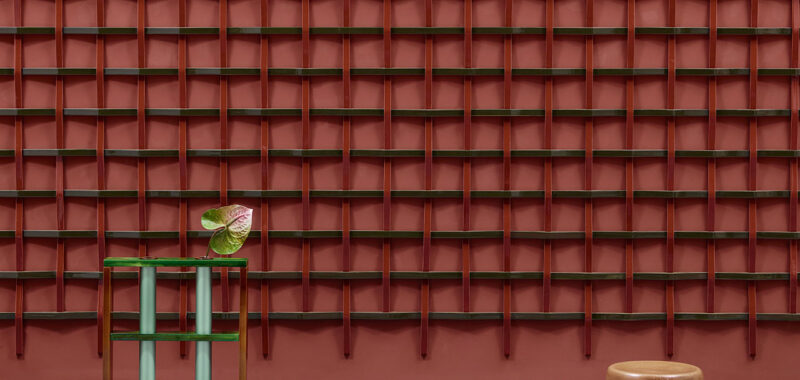In music, an adagio, which means “slowly” in Italian, refers to a slow tempo or pace in a song. It is unhurried, leisurely, and intentional. The same can be said about the creation of Adagio, a new tile project designed by the inimitable Ronan Bouroullec for Mutina, which revolves around a single ceramic module. By itself, Adagio is quite simple, but as you configure dozens of the modules together, slowly (that is, in adagio), a grand sculpture comes together, transforming blank walls into gallery-worthy installations.

This is an unprecedented use of ceramics, an idea that could only be realized through Mutina’s innovative and unmatched manufacturing and Bouroullec’s unrivaled ingenuity. The precise notch on the back of the Adagio elements allows them to be interlocked, creating a reticular structure reminiscent of woven fabric. The module is double-fired as a white paste ceramic and then hand-finished to an ultra glossy shine. Adagio comes in five shiny glazes: Bianco (white), Grigio (gray), Rosso (red), Blu (blue), and Verde (green); and in five combination sets of two colors: Grigio + Blue (gray + blue), Grigio + Bianco (gray + white), Grigio + Verde (gray + green), Rosso + Blu (red + blue), and Rosso + Verde (red + green). These color combinations take the guesswork out of creating installations with perfectly complementary colors. Simple in form and easy to configure, Adagio makes its effortless to transform unremarkable wall spaces into something extraordinary.



The secret to Adagio’s uniqueness lies primarily in its form. With each module measuring 2.7×30 centimeters (approximately 1×11.8 inches), this minimalist design breaks away from traditional functional constraints and instead adopts a pure architectural sleekness. Its versatility allows for an infinite range of configurations, from well-ordered and enclosed layouts that provide a structured visual effect, to more freeform, open layouts that give an impression of organic, expanding shapes.


Adagio’s structural concept evokes the three-dimensionality of woven fabric, with overlapping elements creating a sculptural texture that adds depth and character to any wall. This three-dimensional quality is accentuated by the high-gloss finish of the ceramic pieces, a result of Mutina’s careful double-firing process and the hand-finishing techniques that give the tiles their lustrous sheen. The specific application of the glaze ensures that all vertical sides of the module are fully covered, enhancing the piece’s sculptural effect.



Beyond its aesthetic beauty, Adagio reflects Mutina’s commitment to sustainability. The base tile body is free from Volatile Organic Compounds (V.O.C.) and other substances of concern, adhering to the highest environmental standards. Additionally, the packaging is fully recyclable, ensuring the project’s eco-friendliness from production to installation.




Adagio made its debut at the Résonance exhibition earlier this year at the Centre Pompidou in Paris. Curated by Marie-Ange Brayer and Olivier Zeitoun, the exhibition celebrated the prolific career of Ronan Bouroullec, showcasing his influential role in contemporary international design. In this exhibit, Adagio was displayed on an entire wall, serving as a backdrop for other Editions designed by Bouroullec for Mutina. The installation not only highlighted Adagio’s versatility but also demonstrated its ability to harmoniously combine different color palettes and configurations. Adagio’s presence at this exhibition cemented its longevity, and it has since become part of the permanent collection at the Centre Pompidou.








 \
\

To learn more about Adagio by Ronan Bouroullec, visit mutina.it.
Photography by Gerhardt Kellermann.

